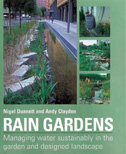Rain Gardens
The numbers are eye-popping: Just about one percent of all the water on Planet Earth exists as fresh water suitable for human consumption. And depending on where you live in the United States, anywhere from a quarter to almost half of that precious resource
If you spend as much time as I do reading the myriad journals available to the landscape trades, you’ll no doubt have noticed their intense concentration on water quality and preservation. It’s about time these issues came to the fore: We’ve spent so much time as a society focusing on making our lives easier that many of us seem to have forgotten that water is a finite resource. Rest assured: I’m not somebody who believes that environmentalism is all about undermining the desire for beauty or luxury. Nonetheless and now more than ever before, it is apparent that we must find ways to manage, preserve and marshal dwindling water resources while at the same time we must continue to offer our clients spaces in which they can gather to enjoy beauty, tranquility or recreation. The hard fact is, only about three percent of the water on this planet can be
The numbers are eye-popping: Just about one percent of all the water on Planet Earth exists as freshwater suitable for human consumption. And depending on where you live in the United States, anywhere from a quarter to almost half of that precious resource is used for irrigation. This is why it’s so important for those of us who design watershapes and exterior environments to consider options that minimize our use of potable water to maintain the landscape – and why I’m glad I picked up a copy of Rain Gardens by Nigel Gunnett and Andy Clayden (Timber Press, 2007): This 190-page text defines specific steps we can all take to replace municipal or well water with rainwater, capturing a gift from the skies and using it to sustain our landscapes. As the authors point out, we live in a time when drought is
It seems that everyone’s talking about “sustainability” these days, with the usual thought being that, as exterior designers, good environmental stewardship must be one of our main missions. But what is sustainability? What do watershapers need to do to encompass this philosophy? As important, what does it mean to our clients, and where are they in all of this? According the numerous sources I’ve consulted, sustainability is defined as striving for the best outcome for both human and natural environments, now and well into the future. In other words, it’s about

















